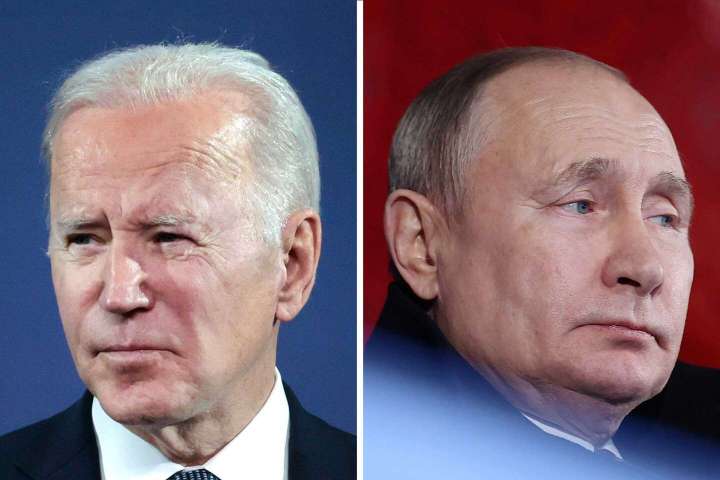Conventional wisdom is crystallizing in Washington that if Russian President Vladimir Putin used a nuclear weapon in Ukraine, the United States would automatically become a combatant in the war. “Just to give you a hypothetical,” retired Gen. David Petraeus said on Sunday. NATO “would take out every Russian conventional force that we can see and identify on the battlefield in Ukraine and also in Crimea and every ship in the Black Sea.”
Biden’s instincts to avoid war are sound — even if Putin goes nuclear

The Pentagon must plan for all scenarios, but the case for direct U.S. military intervention in Ukraine is dangerously weak. It was weak at the start of the war, and it will be just as weak if Putin resorts to weapons of mass destruction at its ignominious end.
President Biden’s strategy of avoiding direct U.S. involvement in Ukraine — criticized by hawks since the war’s early days — is working. Once Russian tanks rolled in February, three outcomes became possible. The first is the one both Putin and U.S. intelligence apparently expected: that Russia would swiftly overrun the country and Kyiv would fall. The second was a grinding stalemate, with lines of control eventually stabilizing somewhere in Ukraine’s east. The third was a comprehensive Ukrainian victory.
The closer Ukraine can get to that third outcome, the better for the United States’ interests in the long run. But a nuclear crisis stands in the way. That was always clear: Russia keeps a massive stockpile of low-yield weapons intended for battlefield use in situations it considers vital to its survival, which could include the failure to hold territories in eastern Ukraine.
As Russian forces suffer a weeks-long string of defeats, the prospect of Ukrainian victory is becoming thinkable without the United States having ever sent its army to the battlefield or air force to the skies. To say now that Washington must join the war directly if Putin goes nuclear would turn Biden’s successful strategy upside down. It would mean that the fruit of success is not greater American security but a greater likelihood that the United States will become a combatant in a major war.
Follow Jason Willick‘s opinions
FollowThe Biden administration’s goal from the outset has been to support Ukraine with arms and logistics and punish Russia for its aggression without putting Americans in harm’s way. It has done so. And if Putin in desperation detonates a nuclear device — which would likely have limited battlefield effectiveness — the Biden administration can continue its support, with more and more potent weapons, as long as Ukraine wants to keep up the fight.
But any U.S. guarantees to join the war if Putin breaks the nuclear taboo could distort Ukraine’s decision-making. Thus far, Western officials have said that Ukraine should decide for itself when and whether to seek a cease-fire with Russia. As the country fighting for its survival, it is best equipped to know the benefits and risks.
That’s true as long as the physical battlefield is limited to Ukraine. But if Russian nuclear escalation in Ukraine would automatically trigger a shooting war between NATO and Russia, as many in Washington now seem to expect, then the risks of the war in eastern Ukraine would be spread across the Western alliance, like an insurance policy. And Ukraine would take on more risk than it otherwise would.
No one can predict how a war with Russia would play out, but the fundamentals point in a dark direction. Yes, NATO could try to restore nuclear deterrence by using its superior conventional forces to severely damage Russia’s. But that could prompt Russia to try another round of nuclear escalation. As one analyst observed, nuclear war is “the only level on which Russia enjoys parity with the United States.” Each round of escalation could narrow the destruction gap between Russia and the West.
A nuclear strike by Russia against Ukraine would indeed change the world, but the United States’ refusal to join the war directly would not. NATO has declined to bring Ukraine into its defense perimeter. NATO members are covered by America’s nuclear umbrella, as are treaty allies such as Australia, Japan and the Philippines. The credibility of those guarantees would not be at stake.
What about America’s relationship with Taiwan? Like Russia in Ukraine, Beijing would surely try nuclear blackmail in a war over the island. Yet China is a greater strategic threat to U.S. strategic interests than Russia is, and the fall of Taiwan would jeopardize the United States’ alliance structure in the Pacific. The decision not to fight in Europe doesn’t lock Washington into any course in Asia. Better to build deterrence through military investments that convince China the United States would prevail in a conventional war.
“Let justice be done, though the heavens may fall” is a legal maxim that can’t be realized in domestic law, much less foreign policy in the nuclear age. The restoration of all of Ukraine’s territory is just — and NATO should back Kyiv regardless of Putin’s nuclear threats. But as the war bends toward a just outcome, it would be a mistake to invite the heavens to fall.






